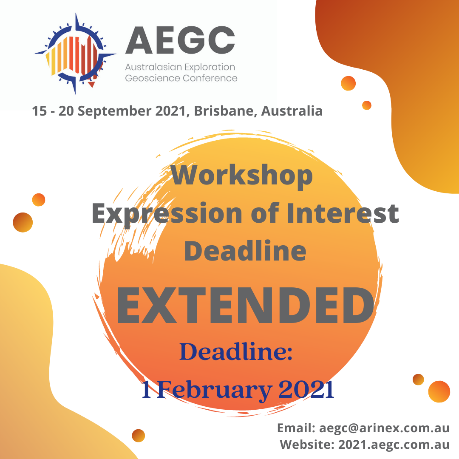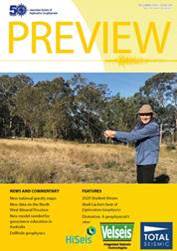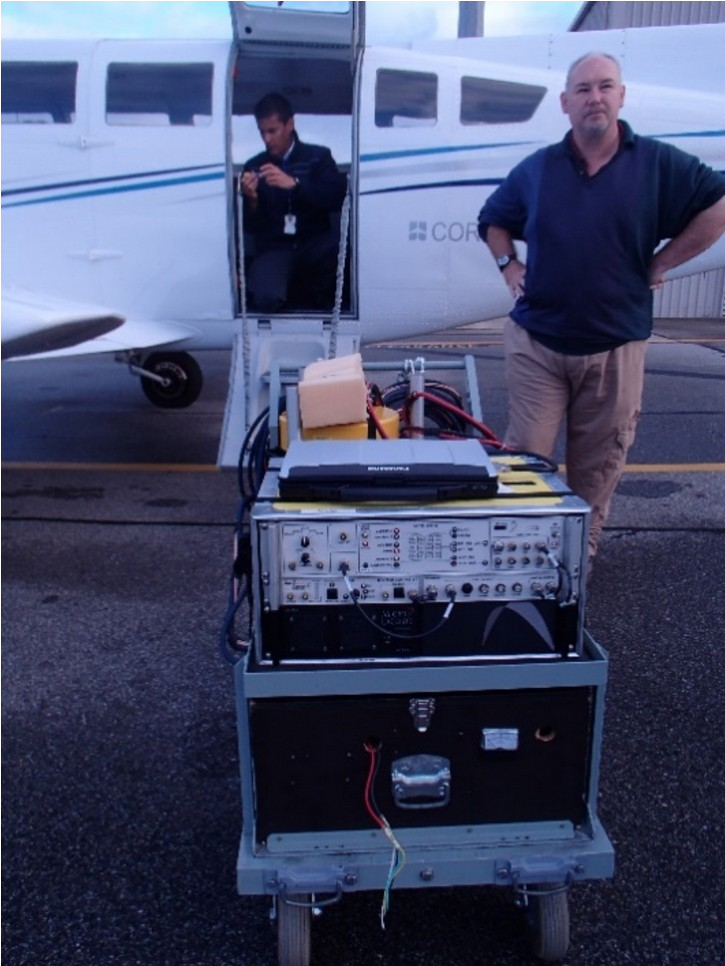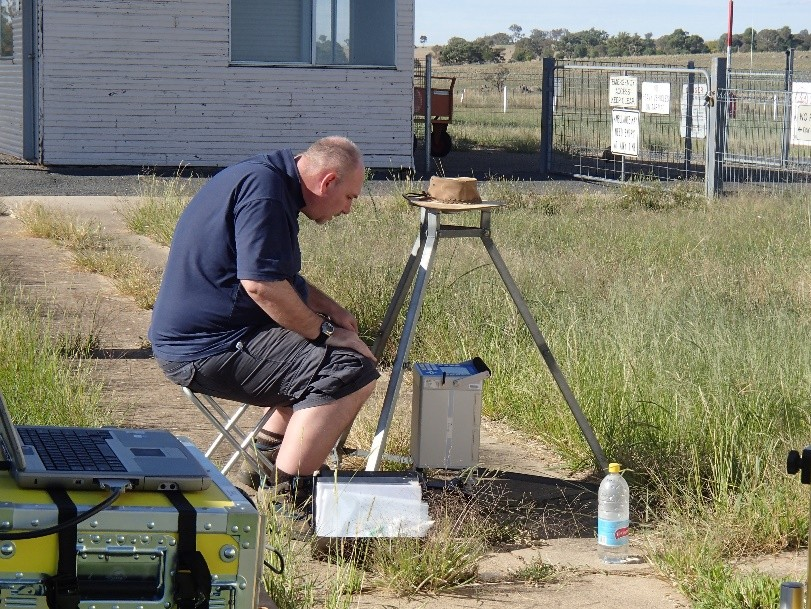|
For optimal viewing, we recommend you view this newsletter in your browser, click here
ASEG Newsletter | Issue 33 | January 2021
Dear Members,
Welcome to the first newsletter of 2021. In this Newsletter you will read about:
Federal Executive AGM
STA STEM Ambassadors
AEGC Workshop expression of interest extended!
EOI for papers for special issue
ASEG Research Foundation Grants open
CODES Short Courses
The Geophysical Sustainability Atlas: Mapping geophysics
to the UN Sustainable Development Goals
Vale Richard Lane
Renew Membership
And of course, our regular articles.
For updates on upcoming webinars, events and interesting articles follow ASEG on LinkedIn, Twitter and Facebook.
Federal Executive AGM
| The 2021 AGM for the Australian Society of Exploration Geophysicists (ASEG) will be held on Tuesday 6 April 2021 at 17:30 AEDT on zoom. For the full Notice of Annual General Meeting, including registration link, agenda and nomination process will be sent to members once details are finalised. Please contact secretary@aseg.org.au for further information. |
STA STEM Ambassadors
Science and Technology Australia (STA) are seeking ambassadors to be involved in the STEM Ambassadors program. This program will build on the Science meets Parliament program to forge stronger ties between Members of Parliament and STEM professionals. Ambassadors would be offered advanced skills training on policy and how to engage effectively with MPs, Senators and Governments.
For more information and to apply, visit STEM Ambassadors website.
AEGC Workshop expression of interest extended!
 |
Deadline extended to 1 February 2021 (midnight) for expressions of interest to present a workshop at the 3rd AEGC. The conference will run from the 15 - 20 Sept 2021 with workshops to be hosted on 15, 16 & 20 September. If you are interested in presenting a workshop, please register your interest and supply the Workshop title and a Brief summary to aegc@arinex.com.au. For more information visit the AEGC Conference website. |
EOI for papers for special issue
Submissions for expression of interest are open for the Special issue "Near-surface geophysics for mineral exploration and mining". This special issue invites papers which focus on emerging geophysical techniques for mineral exploration and mining, novel modeling and interpretation approaches, including joint inversion of multiphysics data and representative case studies. Visit the website for more information.
Timeline
Submission of expression of interest (10-15 lines): Feb 28, 2021
Submission of full manuscript: May 31, 2021
Final decision on accepted manuscripts: December 15, 2021
Publication Special Issue: February 2022
ASEG Research Foundation Grants open
Applications for the ASEG Research Foundation Grants are now open. Each year ASEG Research Foundation awards grants to research projects at an Honours, Masters or PhD level. Projects must be completed at Australian institutions and involve Exploration Geophysics. For more information, and to apply visit the ASEG Foundation webpage. Grants close 1 March 2021. The ASEG Research Foundation can only carry on its work through generous donations from individuals and companies.
CODES Short Courses
University of Tasmania through CODES will be offering short courses located in Tasmania.
Advanced Field Skills in Economic Geology
7-20 February 2021
Field-based
https://bit.ly/3hb8npS
Geodata Analytics
8 February to 16 April 2021
Fully online
https://bit.ly/3qej2mL
The Geophysical Sustainability Atlas: Mapping geophysics to the UN Sustainable Development Goals
The SEG have released an article mapping geophysics to the Sustainable Development goals. Read more at https://library.seg.org/doi/full/10.1190/tle40010010.1.
Vale Richard Lane
Richard Lane passed away New Year's Day. Richard was awarded the ASEG Gold Medal in 2017 for significant and distinguished contributions to the profession of geophysics in Australia and overseas through his widely recognised practical research and contributions to the understanding and application of geophysical methods in both mining and petroleum, for his frequent contributions at conferences both in Australia and overseas, and through his outstanding professional work in applied geophysics for over 30 years. The detailed Citation for the award of our Society's highest honour to Richard was published in Preview 188.
Renew Membership
A reminder that membership fees were due at the end of 2020.To renew your membership for the 2021 year, visit Currinda or contact secretary@aseg.org.au.

Follow our social media pages to stay up-to-date with the latest talks. Past talks can be found on the ASEG Videos Page.
Recommend a talk suggestion? Email communications@aseg.org.au.
ASEG Webinars
| Date |
Presenter |
Title |
Registration Link |
Thurs 28 January
1000 (AWST)
|
Prof Eun-Jung Holden,
(UWA) |
Geological Knowledge Discovery using Machine Augmented Intelligence |
TBA |
Tues 2 February
1230 (AWST)
|
Dr Mehdi Torq Qashqai,
(CSIRO) |
Seismic imaging of the crust using Bayesian joint Inversion of teleseismic P-wave coda autocorrelation waveforms |
Zoom Link |
Tues 16 February
1300 (AEDT)
|
Dr Kate Selway,
(Macquarie University) |
To be confirmed |
Zoom Link |
SEG Webinars
The SEG are hosting a range of Webinars that are free to attend but require pre-registration.

Branch upcoming events
COVID19 has impacted in-person state branch activity for some branches. Information for ASEG Branch events are updated on ASEG website.
| Branch |
Date |
Event |
Venue & More Info |
| NSW |
Wed 17
February
|
AGM + talk |
Club York |
| QLD |
Tue 9
February
1730 (AEDT) |
The World of Environmental Geophysics (Geophysics in the Near Surface) |
XXXX Brewery |

For a more complete calendar of events see Preview
| Date |
Event |
|---|
| 25-27 May 2021 |
AustMine, Perth, Australia
|
| 15-20 September 2021 |
AEGC 2021, Brisbane, Queensland
|

ASEG members can access Exploration Geophysics articles free of charge by logging into the ASEG website and navigating to Professional > Publications > Exploration Geophysics.
Hi all,
I trust you are all well and avoided COVID last year as well as finding time to get some extra reading of Exploration Geophysics done. Who knows where 2021 will take us....but to start the ball rolling may I recommend the following two new articles. As well, if you have that unfinished case history sitting on the shelf, now is the time to finish it and submit!!!
The first paper is by Robert Brown and co-authors looking at the GPR of some Roman ruins.
The second paper is by Jun Kyoung Kim and co-authors who investigated s-wave velocity structures of a dam using amplification characteristics using H/V spectral ratios.
Cheers,
Dr Mark Lackie
Exploration Geophysics Editor
eg-editor@aseg.org.au

The December issue of Preview is now available online
 This issue of Preview is a bumper issue. Don Emerson investigates divination and, as is apparent from the image on our cover, clearly enjoyed putting several divining rods through their paces. Mark Lackie, the current Editor-in-Chief of Exploration Geophysics makes the final selection in our "best of" series, marking the 50th anniversary of the establishment of the Australian Society of Exploration Geophysicists. We also feature our annual summary of theses completed in Australia that are based on, or use, geophysical methods (Education matters). Michael Asten prefaced this summary with a invited piece from David Cohen, President of the UNSW Academic Board and the Australian Geoscience Council, on the current state of geoscience education in Australia. Our other commentators have also delivered. David Denham (Canberra observed) introduces Australia's new Chief Scientist and, as usual, muses on Canberra politics. Mike Hatch (Environmental geophysics) has a play with some data from the new Loupe system. Terry Harvey (Mineral geophysics) reviews drillhole geophysics. Mick Micenko (Seismic window) reflects on the seismic method - pun intended! Tim Keeping (Data trends) looks at pseudo data, artefacts and recursion, and Ian James (Webwaves) celebrates a great leap forward in Preview's presence on the ASEG website. This issue of Preview is a bumper issue. Don Emerson investigates divination and, as is apparent from the image on our cover, clearly enjoyed putting several divining rods through their paces. Mark Lackie, the current Editor-in-Chief of Exploration Geophysics makes the final selection in our "best of" series, marking the 50th anniversary of the establishment of the Australian Society of Exploration Geophysicists. We also feature our annual summary of theses completed in Australia that are based on, or use, geophysical methods (Education matters). Michael Asten prefaced this summary with a invited piece from David Cohen, President of the UNSW Academic Board and the Australian Geoscience Council, on the current state of geoscience education in Australia. Our other commentators have also delivered. David Denham (Canberra observed) introduces Australia's new Chief Scientist and, as usual, muses on Canberra politics. Mike Hatch (Environmental geophysics) has a play with some data from the new Loupe system. Terry Harvey (Mineral geophysics) reviews drillhole geophysics. Mick Micenko (Seismic window) reflects on the seismic method - pun intended! Tim Keeping (Data trends) looks at pseudo data, artefacts and recursion, and Ian James (Webwaves) celebrates a great leap forward in Preview's presence on the ASEG website.
Proposed contributions for future issues can be submitted by email to the editor at previeweditor@aseg.org.au
Lisa Worrall
Preview Editor
PreviewEditor@aseg.org.au

This month we shine the spotlight on Phill Wynne; a long-time member of the ACT branch and geophysicist at Geoscience Australia.

|

|
| Phill Wynne setting up the CG5 gravity meter for a demonstration at Ferry Creek Primary School. |
Phill unloading some of the equipment for measuring gravity at one of the Australian Fundamental Gravity Network (AFGN) sites. |
- What is your current role?
Dealing with gravity for Geoscience Australia. I manage the ground gravity database, acquisition via contractors, partnering with the states and Territory for surveys, make the data available to the public (point located data, grids, and compilations of both), plus any questions that come along. As part of that work includes maintaining the Australian Fundamental Gravity Network, a series a reference benchmarks that ties all ground, airborne, and marine surveys together.
- What do you like most about being a geophysicist?
I think that for me it is seeing is the gradual increase in the understanding of what is there beneath our feet and finding something unexpected that changes the way we think about what is going on. Sometimes I am also fortunate enough to see the result of all that work (from the contractors, states/Territory, and other areas of GA) have a practical effect on people, such as a new water source or an area of new potential mineral or energy resources.
- What is your best interview tip?
Organise your thoughts when answering, don't rush. Always take a moment before answering a question to make sure you are answering what has been asked, not what you think has been asked. Don't be afraid to ask for clarification if you are not sure what the focus of the question is.
- What's one thing that we wouldn't know about you?
While I am left-handed, I'm not left footed but slightly right footed. My first step, putting on pants, socks, and shoes, picking up objects with my toes, etc. are all with the right foot/leg. About the only thing I do predominately with my left foot is kick. Apparently, most people that are right-handed are also right footed, but this is less so for left-handed people.
- Where was your best sunrise/sunset location?
Best sunset was when flying into Broome, sometime around 2007-08. The sun was setting on a cloudless day, touching the horizon and giving the ocean a gold and silver sheen. Best sunrise was north and west of Kalgoorlie in WA. The sun making the clouds look red/purple as if a storm was coming.
- What are you reading now?
Battleground by Jim Butcher's. It's the 17th book of an urban fantasy series called the Dresden Files set in Chicago. It has a film noir sense of mystery, with comedy, horror, and mythology from all around the world meshed into a very entertaining world. Dresden is a "consulting wizard" that has to deal with everything that a normal PI has to deal with plus the supernatural world. Battleground deals with the fallout of an ancient power declaring war against humanity.
- Your funniest or worst field memory?
Worst would be having two tires staked at the same time twice in a single day, and then repairing them in 35°C plus temperatures. The only funny experience in the field that has stayed with me for many years is finding a foam esky (it was the late 1990's) nailed halfway up a tree with "supplies" written on the side.
- Your most respected geophysicist?
While there are several geophysicists that I respect, the one I respect the most is Richard Lane, who unfortunately passed recently. A mountain of knowledge and a willingness to share it to anyone interested, taking the time to explain things. Very meticulous in his works and willing to do tasks that were dull but necessary. Involved in the development of several exploration techniques and processes. I was fortunate enough to work beside and with him over more than 15 years and learnt a great deal from.
- When you are asked "What's a geophysicist??" or "What does a geophysicist do?" what is your stock answer?
My stock answer has been: We use the physical properties of the earth to better understand the geology to allow us to find what we are looking for or trying to understand. This will allow us to find minerals, water, or whatever else we are looking for. Different rocks, materials, and structures will have a different density, respond differently to magnets, etc., and it is these changes that we measure to help figure out what is going on.

Photo: Phill Wynne using CG5 a gravity reading at an AFGN site near Young, NSW.
- What is a challenge that you see in geoscience today, and how do you see the community overcoming it?
In my experience a lot of people seem to think that geophysics either doesn't provide answers, or it provides an exact answer, not that it is a tool the assists you to find an answer. While geophysics can provide a lot of information about what is going on, it doesn't often provide a single "true" answer, with interpretations still requiring someone to go and test the interpretation on the ground. I've used the analogy of a fuzzy picture, with geophysics (plus other disciplines) making the image clearer, but you never quite have all the details for a definitive answer until you go there to see for yourself.
- Do you think AI will take over your job or will the human element remain vital to exploration successes?
I can't see AI taking over the human element for exploration or interpretation any time soon. I do see it AI becoming a tool that will assist people's work in the next 10 years or so. I get the feeling that it'll work like a teacher/student relationship, teach the AI a specific task/pattern recognition, have it search for the pattern, and hand back the areas of interest for someone to investigate further. AI might also have an impact in other areas like data acquisition. For example, the use of drones. Having an AI that can respond to the conditions quickly it would provide a more stable platform allowing for better quality data to be collected.

|